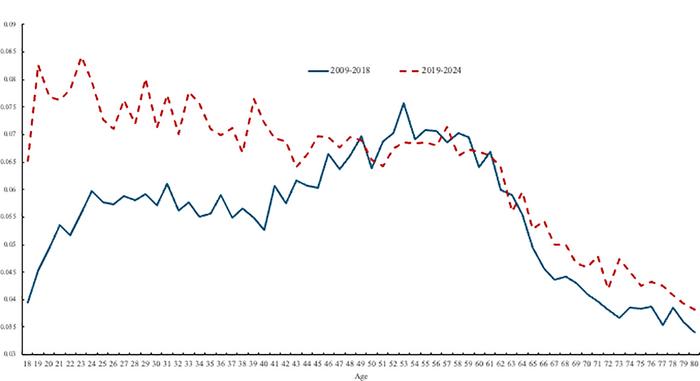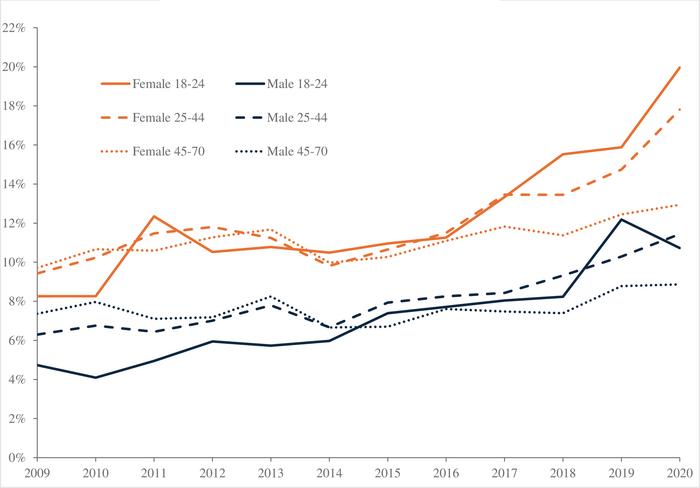Good news, the dreaded midlife crisis may be about to become a thing of the past. The bad news, however, is that this is not due to positive societal improvements, but because young people’s mental health is declining already.
The midlife crisis, a characteristic period of self-doubt, identity crisis, and emotional upset, is a common transitional experience for many people. Within the scientific literature, this midlife trough has been documented in over 600 studies across the world and across time. It is a U-shaped trend in wellbeing which gradually drops after childhood until around the age of 50 and then rises again as people reach old age. It has been noted across a whole range of metrics, including life satisfaction and happiness.
Scientists have also identified a corresponding phenomenon, known as the “ill-being” or “unhappiness hump” that occurs at the same time. This is a trend consisting of increased worry, stress, and depression that comes with age, reaching its peak in midlife and then decreasing thereafter.
At its deepest, it’s the time when people will dramatically change jobs, buy an expensive sports car, get divorced, or start extramarital affairs. Although the way people respond to this period varies from person to person, it nevertheless stems from a pretty consistent experience. But that may be about to change, according to new survey-based study by researchers at Dartmouth College, University College London, and the Institute for Fiscal Studies.

The unhappiness hump (in blue) has been replaced by a more gradual decline in wellbeing among younger people.
Recent data indicates that there is a worldwide decline in wellbeing among young people, but this data hasn’t been directly considered in relation to the unhappiness hump. To address this, the researchers analyzed data from US and UK surveys that included questions about participants’ mental health.
The information they collected came from more than 10 million US adults surveyed by the Centers for Disease Control and Prevention between 1993 and 2024, while the UK data covered the years between 2009 and 2023. The latter was collected as part of an ongoing US Household Longitudinal Study, involving 40,000 households.

Despair among people of different ages and genders in the UK has been increasing since 2009, with females (orange) in all age groups experiencing it the most.
The data indicates that in both countries, the unhappiness hump has disappeared, being replaced by a trend where ill-being/unhappiness gradually declines over the course of a lifetime. The hump appears to have vanished because the ill-being of people in their late 40s and above did not change significantly from before. Instead, there seems to be a much larger decline in mental health among younger people.

Despair in the US has been rising for all surveyed categories since 1993 (dark blue: female age <25>25 and >high school education).
To confirm this, the researchers then analyzed data from nearly 2 million people from 44 countries, including the US and the UK. The data was taken from a mental health study called Global Minds, which covered the years between 2020 and 2025. This information also suggested the unhappiness hump as disappeared across the world.
Exactly what has caused this change remains unclear. The researchers speculate that there may be several reasons, including the long-term impacts of the Great Recession on job prospects, underfunded mental healthcare services, issues posed by the COVID-19 pandemic, and the increased use of social media.
“The well-being U-shape in age and the hump-shape in ill-being has been described by one of us as ‘among the most striking, persistent patterns in social science’”, the team write in their paper.
“This is no longer the case. Instead, subjective ill-being falls with age, in the United States, the United Kingdom and in 42 other countries. In the United States and the United Kingdom, we can show that this change has come about because the mental health of the young has deteriorated compared to that of older people. It seems reasonable to infer that the same underlying changes account for the age pattern in illbeing we observe across the world in the Global Minds data for 2020–2025.”
In a statement, the authors added: “Ours is the first paper to show that the decline in young people’s mental health in recent years means that today, both in the United States and the United Kingdom, mental ill-being is highest among the young and declines with age. This is a huge change from the past when mental ill-being peaked in middle-age. The reasons for the change are disputed but our concern is that today there is a serious mental health crisis among the young that needs addressing.”
The study is published in PLOS One.
Source Link: Gen Z Might Not Be On Course For A Midlife Crisis – Good News, Right? Wrong